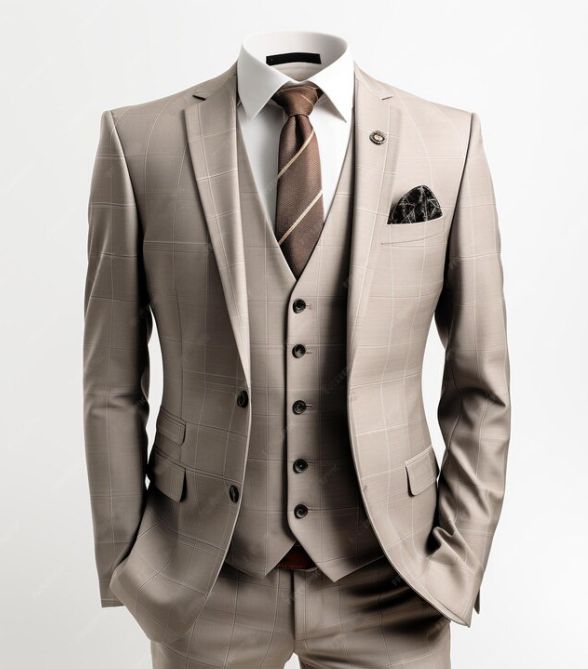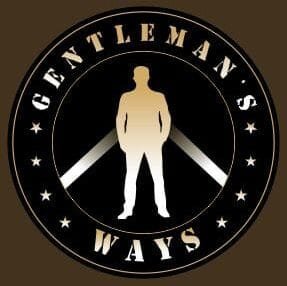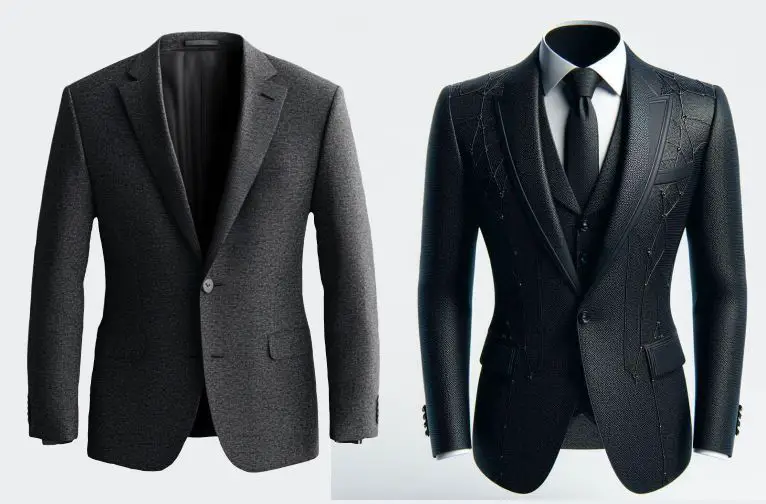Last updated on May 8th, 2025 at 04:31 am
Discover the key differences between a blazer vs suit jacket. Learn when to wear each, how to style them, and why knowing the distinction is essential for your wardrobe.
In men’s fashion, blazers vs suit jackets are often mixed up. Both are stylish wardrobe staples, but they have different functions and designs.
Knowing the difference between the two helps you pick the right one for the occasion and avoid confusion when getting dressed.
Blazers are more relaxed, made from various fabrics, and often without matching trousers.
They come in a range of colors and patterns, perfect for semi-formal or smart-casual events.
On the other hand, suit jackets are part of a matching set, made from the same fabric as the trousers.
These jackets are more structured and best for formal events or business meetings.
In this article, we’ll break down the key differences in fabric, fit, and style so you can confidently choose between the two for any occasion without misaligning with men’s fashion rules.
Recommended: Fashion and Style Guide for Men
Table of Contents
- Defining Blazer and Suit Jackets
- Blazer vs Suit Jacket: Differences at a Glance
- When to Wear a Blazer vs a Suit Jacket
- How to Choose Between a Blazer and a Suit Jacket
- Common Styling Mistakes to Avoid
- Frequently Asked Questions about Blazer vs Suit Jacket
- Conclusion
Defining Blazer and Suit Jackets
What is a Blazer?

A blazer is a tailored jacket designed to be worn over a shirt or sweater, offering a smart-casual or semi-formal look.
Unlike a suit jacket, it isn’t part of a matching set, making it suitable for pairing with various trousers.
Blazers have a structured fit, often with padded shoulders to give a polished appearance, while still allowing comfort and movement.
Common fabrics for blazers include wool, tweed, cotton, and linen, each providing a distinct style and seasonal functionality.
The navy blazer is a classic choice, offering timeless elegance that works for business settings, dinners, or casual outings.
What is a Suit Jacket?

A suit jacket is a formal garment that forms part of a matching set, typically worn with trousers made from the same fabric. It is known for its sharp, tailored silhouette, providing a more structured and fitted appearance than a blazer.
Suit jackets often feature specific elements like notch or peak lapels, well-defined shoulders, and a slim waistline, all contributing to a polished, sophisticated look.
Made from high-quality materials such as wool or silk blends, suit jackets are the preferred choice for business meetings, weddings, and other formal events where a refined style is required.
Related Posts
- Men’s Casual Blazers and How to Choose
- Men’s Blazer Size Chart: Find Your Perfect Fit
- Guide to Picking a Men’s Blazer
- How to Wear a Men’s Blazer Jacket with Jeans
- Guide to Men’s Fashion Accessories
- What’s the Difference Between Blazers vs Sport Coat vs Suit Jacket
- Cheap Blazers, How Good Are They?
- Summer Blazer Jacket Ideas
Blazer vs Suit Jacket: Differences at a Glance
When you’re choosing between a blazer and a suit jacket, it’s important to understand how they differ in fabric, fit, structure, and where they work best. Knowing these differences can help you make the right decision for any occasion.
Fabric: Casual vs Formal
Blazers are usually made from fabrics like cotton, linen, or wool blends. These materials give the blazer a more relaxed, comfortable feel.
Suit jackets, on the other hand, are made from finer fabrics like worsted wool, which creates a polished, formal appearance.
The fabric choice affects both how the garment looks and how it feels to wear.
Fit and Structure: Relaxed vs Tailored
Blazers have a more relaxed fit, with softer shoulders and a more laid-back structure. This makes them easy to wear and move in.
Suit jackets are more tailored, with a sharper, structured look that creates a clean, polished silhouette.
The presence of padding, vents, and overall construction plays a big role in determining how formal the jacket feels.
Occasions: Casual vs Formal Settings
Blazers are great for a wide range of events. Whether it’s a casual get-together or a smart-casual dinner, a blazer works well in both settings.
It pairs with trousers or even jeans. Suit jackets, however, are more fitting for formal events like business meetings, weddings, or galas. They are best worn with dress trousers and a formal shirt.
Related: How to Wear a Slim-fit Blazer
Pairing: Mixing Casual with Smart-Casual vs Strictly Formal Wear
Blazers can easily be paired with smart-casual attire, giving you flexibility in your wardrobe.
Suit jackets, however, demand more formal pieces to match them, such as dress trousers, shirts, and ties.
The decision between a blazer and a suit jacket comes down to the occasion and how formal you want to look.
Understanding these differences will help you choose wisely for any event.
Button Styles: Single vs Double Breasted
Blazers often come in both single-breasted and double-breasted styles, giving you more options for casual or semi-formal looks.
Double-breasted blazers are often considered slightly more formal, but they still don’t reach the level of a suit jacket in terms of strict formality.
Suit jackets, however, are almost exclusively single-breasted, with double-breasted versions still mostly reserved for more formal occasions or traditional suit styles.
Lapels: Narrow vs Wider
Blazers usually have a more relaxed lapel design, often narrower or less sharply defined.
This is in line with their more casual or semi-formal nature.
Suit jackets, in contrast, typically feature sharper, more defined lapels, and the width of the lapel can also indicate how formal the suit jacket is.
Wider lapels are often associated with more classic or formal suit styles.
Related: Everything to Know about Designer Blazers
Pockets: Flap vs Jetted
The pockets on a blazer tend to be more functional and visible, typically featuring flaps that give a more relaxed look.
Suit jackets, on the other hand, usually have jetted pockets, which are sleek and less conspicuous.
This subtle difference in pocket design further adds to the formal appearance of the suit jacket compared to the more casual blazer.
Lining and Interior Construction: Simple vs Detailed
Blazers tend to have a simpler interior construction, often with less detailed lining or internal structure.
The lining may be lighter or absent in certain blazers, keeping them comfortable for casual wear.
Suit jackets are usually more complex in terms of interior details, with higher-quality linings, additional internal pockets, and more precise tailoring.
This extra detail contributes to the more formal and polished appearance of suit jackets.
Here’s a clear comparison between a Blazer vs Suit Jacket in a tabular format:
| Key Differences | Blazer | Suit Jacket |
|---|---|---|
| Fabric | Casual fabrics like cotton, linen, or wool blends, offering a more relaxed feel. | Finer fabrics like worsted wool, creating a polished, formal appearance. |
| Fit and Structure | Relaxed fit, softer shoulders, and a laid-back structure, making it comfortable and easy to wear. | Tailored fit, structured with padding and vents for a clean, polished silhouette. |
| Occasions | Suitable for casual and smart-casual events like dinners or informal gatherings. | Best for formal occasions like business meetings, weddings, or galas. |
| Pairing | Pairs well with smart-casual attire like trousers or jeans for a flexible look. | Pairs with dress trousers, formal shirts, and ties for strictly formal wear. |
| Button Styles | Available in both single-breasted and double-breasted styles, with double-breasted being more formal. | Primarily single-breasted, with double-breasted options for traditional, formal styles. |
| Lapels | Narrower, less sharply defined lapels for a casual or semi-formal look. | Sharper, more defined lapels, with width indicating the formality of the jacket. |
| Pockets | Flap pockets that are more functional and visible, adding to the relaxed feel. | Jetted pockets, sleek and less visible, contributing to the formal look. |
| Lining and Interior Construction | Simpler interior with lighter or absent lining for comfort. | Detailed interior with high-quality linings, internal pockets, and more precise tailoring. |
When to Wear a Blazer vs a Suit Jacket
When deciding between a blazer and a suit jacket, consider the event’s formality.
A blazer is perfect for business casual settings and less formal events like smart-casual gatherings or client meetings.
Pair it with chinos or dark jeans for a professional yet comfortable look.
In contrast, a suit jacket is best for formal occasions like weddings, corporate events, or important meetings, offering a sharp, polished appearance with matching trousers.
For semi-formal events, elevate a blazer with a dress shirt, tie, and dress shoes to make it more refined.
Knowing when to wear each ensures you are appropriately dressed for any occasion.
Recommended: Why You Should Consider Custom Blazer Jackets
How to Choose Between a Blazer and a Suit Jacket
When deciding between a blazer and a suit jacket, it’s important to think about your wardrobe needs, the types of events you attend, and your personal style.
Both pieces serve different purposes and can affect how you present yourself.
Consider Your Daily Activities
Start by considering your lifestyle. If your daily activities lean toward casual environments, a blazer may be a better fit.
Blazers are adaptable and work well in settings ranging from semi-formal to casual.
On the other hand, a suit jacket is more suited for formal occasions like business meetings, weddings, or events where you need a more polished look.
Think About Event Formality
Event type is another key factor. Pay attention to the event’s dress code.
For a casual dinner, a blazer is appropriate, but for more formal events like a charity gala, a suit jacket will likely be the better choice.
The right attire shows respect for the event and helps you present yourself confidently.
It’s a good idea to keep both a blazer and a suit jacket in your wardrobe for flexibility.
Reflect on Your Style
Your style also plays a role. A blazer gives you room for creativity with colors and patterns, while a suit jacket has a more classic, traditional vibe.
Consider which look fits your personality and how you want to feel in the outfit.
Whether you lean toward modern or timeless styles, making the right choice can enhance your confidence and comfort.
Common Styling Mistakes to Avoid
When styling blazers and suit jackets, avoiding common mistakes can help you create a sharp, put-together look.
Here are some key points to keep in mind to ensure your outfits hit the mark.
Don’t Pair a Blazer with Overly Casual Pieces
A common mistake is wearing a blazer with too-casual items like gym shorts or flip-flops.
While blazers work well for smart-casual outfits, pairing them with overly relaxed pieces can ruin their sophisticated look.
Instead, team your blazer with tailored trousers, smart denim, or chinos for the right balance between casual and formal.
Avoid Wearing a Suit Jacket in Casual Settings
Suit jackets are made for formal occasions. Wearing one in a casual setting, especially with sneakers or a basic t-shirt, creates an awkward contrast.
To keep it appropriate, wear a suit jacket with dress shoes, loafers, or a dress shirt. For a more modern touch, you could also try a well-fitted turtleneck.
Be Mindful of Layering
Layering can be tricky. Avoid wearing thick sweaters or bulky layers under a blazer or suit jacket.
These can make the fit uncomfortable and disrupt the overall look. Instead, opt for lightweight fabrics that fit smoothly under your jacket.
Pairing a textured blazer with a crisp, smooth shirt adds a polished touch to your outfit.
Focus on the Right Fit
The fit of your blazer or suit jacket is critical. A jacket should fit snugly at the shoulders, with sleeves ending just above your wrist bone.
Avoid oversized or poorly fitted jackets, as they can make you look sloppy.
A well-fitted blazer or suit jacket instantly enhances your appearance and makes you look more refined.
Frequently Asked Questions about Blazer vs Suit Jacket
Can a blazer be worn for formal occasions?
Blazers can be worn for formal events, but they traditionally pair better with semi-formal or smart-casual attire.
The fabric and structure of the blazer lend a less structured feel compared to the more formal suit jacket.
However, opting for a well-tailored blazer in a refined fabric can elevate its appearance for more formal settings.
Is a suit jacket suitable for casual wear?
Suit jackets are generally designed for formal occasions or office wear, making them less suitable for casual settings.
They are structured and often paired exclusively with matching trousers. That said, pairing a suit jacket with chinos or jeans can create a sharp look, depending on the context.
How do I choose the right fit for my body type?
When selecting either a blazer or a suit jacket, it’s crucial to consider your body type.
For broader shoulders, opt for a jacket with a structured shoulder to balance proportions.
If you have a slimmer build, a fitted blazer can enhance your silhouette. Additionally, the fabric plays a significant role in how the garment drapes.
Always prioritize comfort and movement while ensuring the fit complements your frame.
Can I mix and match blazers and suit jackets with different trousers?
Mixing and matching can be an effective way to create a versatile wardrobe.
Blazers tend to offer more flexibility, easily paired with various trousers, including chinos, jeans, and tailored shorts.
However, suit jackets should ideally be worn with their corresponding trousers for a cohesive look.
Conclusion
When it comes to blazer vs suit jacket, understanding the differences helps you make smarter style choices.
A blazer offers a more relaxed fit and works well for casual or semi-formal occasions, giving you more freedom to style it with jeans, chinos, or tailored trousers.
On the other hand, a suit jacket is designed to be part of a matching suit and is ideal for formal settings like business meetings, weddings, or formal events.
Knowing when to wear each one ensures you make the right impression. Having both in your wardrobe opens up more options, letting you dress appropriately for any occasion.
References
Pyo Merez is a men’s lifestyle enthusiast and writer about the gentleman’s place and impact on society. Raised by a distinguished gentleman dad, he offers unique insights into how the mind of a gentleman works and how societal norms shape gentlemen’s identity and vice versa.
Through his insightful articles, Pyo taps into the depths of gentleman culture to provide perspectives on etiquette and manners in modern society.

